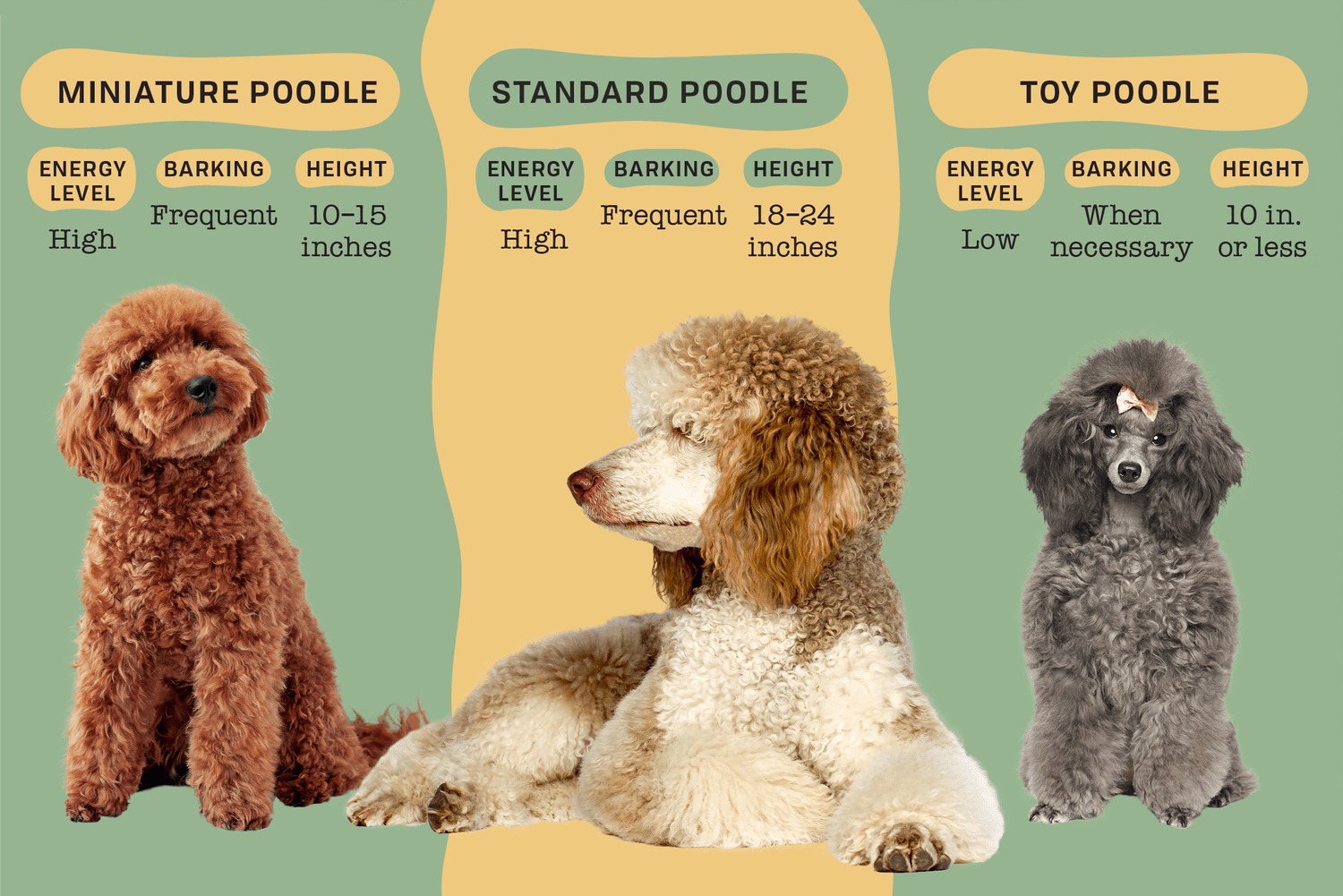In the world of dog breeds, standard poodles stand out for their elegance and intelligence. But have you ever wondered just how big these graceful canines can get? Prepare to be surprised, because standard poodles can reach quite impressive sizes!
Originating in Germany, standard poodles were originally bred to be water retrievers. With their remarkable swimming abilities and innate intelligence, these dogs quickly became popular among hunters. Today, standard poodles are known for their versatility and are often seen in the show ring, excelling in agility competitions, and even working as therapy dogs. But it’s their impressive size that truly sets them apart.
A standard poodle can grow to be quite large, reaching heights between 22 and 27 inches at the shoulder. In terms of weight, they typically range from 45 to 70 pounds. However, keep in mind that each dog is unique and may vary slightly in size. Proper nutrition, exercise, and regular veterinary care can help ensure your standard poodle reaches their full potential size.
:max_bytes(150000):strip_icc()/poodle-miniature-vs-standard-vs-toy-c7f187e50a3441e5886ab428d1368373.png)
The Astonishing Size of Standard Poodles
Standard poodles are known for their elegance, intelligence, and versatility. But one aspect that often captures people’s attention is their size. These impressive dogs can reach quite a substantial height and weight, making them stand out in a crowd. If you’ve ever wondered just how big a standard poodle can get, then you’ve come to the right place. In this article, we will explore the different factors that determine the size of a standard poodle and provide you with all the information you need to know.
Standard poodles are classified as a large-sized breed, and their size is influenced by various factors including genetics, nutrition, and exercise. Let’s delve into the specifics of how big these dogs can actually grow.
1. Breed Standards for Size
The American Kennel Club (AKC), the leading authority on dog breeds in the United States, sets specific standards for the size of standard poodles. According to the AKC, a male standard poodle should measure at least 15 inches at the shoulder, while females should measure at least 14 inches. Keep in mind that these are minimum height requirements, and poodles often grow larger than these standards.
When it comes to weight, male standard poodles typically range between 60-70 pounds, while females generally weigh between 40-50 pounds. However, individual poodles may exceed or fall below these weight ranges based on their build, muscle mass, and overall health.
2. Genetic Factors
The genetics of a standard poodle has a significant impact on its size. Poodles with larger parents are more likely to grow larger themselves. Breeders carefully select parents with desirable traits to create litters of standard poodles that conform to the breed’s size standards. However, it’s important to note that even within the same litter, there can be variations in size.
Genes can affect not only the height but also the overall structure of a standard poodle. Some lines may have a more slender and elegant build, while others may be stockier. It’s always a good idea to inquire about the parent’s size when getting a standard poodle puppy.
3. Nutrition and Exercise
Proper nutrition and exercise are essential for the healthy growth and development of any dog, including standard poodles. Feeding your poodle a well-balanced diet that meets their nutritional needs is crucial for optimal growth. Consult with your veterinarian to determine the ideal food and portion sizes for your poodle based on their age, weight, and activity level.
Regular exercise is also important to keep your standard poodle fit and maintain a healthy weight. Consistent physical activity helps prevent obesity and keeps their joints and muscles strong. It’s recommended to provide your poodle with daily exercise, such as walks, playtime, and mental stimulation activities.
4. Gender Differences
Male and female standard poodles may vary slightly in size. Generally, males tend to be slightly taller and heavier than females. However, keep in mind that individual variations in size can be significant, so it’s essential to assess each dog individually rather than assuming based on gender alone.
5. Growth Stages
Standard poodles go through several growth stages, which can affect their size. Puppies experience rapid growth during their first year, and their height and weight can change significantly during this time. As they transition into adulthood, their growth rate slows down, but they may continue to fill out and develop muscle mass.
It’s important to provide proper nutrition and monitor your poodle’s growth during these stages to ensure they are developing at a healthy pace. Regular check-ups with your veterinarian can help assess their growth and make any necessary adjustments to their diet or exercise regimen.
6. Environmental Factors
Environmental factors can also influence the size of a standard poodle. Adequate living space, exercise opportunities, and mental stimulation can contribute to a poodle reaching its genetically determined size potential. A well-cared-for poodle that receives proper care and enrichment is more likely to reach its maximum size.
Table: Average Height and Weight of Standard Poodles
| Gender | Average Height (inches) | Average Weight (pounds) |
|---|---|---|
| Male | 22-27 | 60-70 |
| Female | 21-26 | 40-50 |
Keep in mind that these are average ranges, and individual poodles may fall outside of these numbers. Other factors, such as genetics and overall health, can influence a poodle’s size.
In Conclusion
Standard poodles can grow to be quite large and magnificent dogs. Their size is determined by a combination of genetics, nutrition, exercise, and environmental factors. While there are general guidelines and breed standards, each poodle is unique and may vary in size. Monitoring their growth, providing proper care, and consulting with your veterinarian will help ensure your standard poodle reaches its full potential in terms of size and overall health.
Key Takeaways: How Big Can a Standard Poodle Get?
- A standard poodle can grow to a height of about 22 to 27 inches at the shoulder.
- The weight of a standard poodle can range from 45 to 70 pounds.
- Male standard poodles tend to be larger than females.
- Genetics play a significant role in determining the size of a standard poodle.
- Regular exercise and a balanced diet are crucial for maintaining a healthy weight and size for a standard poodle.
Frequently Asked Questions
Poodles are known for their elegance, intelligence, and distinctive curly coat. As a popular dog breed, many pet owners are curious about the size and height of a standard poodle. Here are some frequently asked questions about how big a standard poodle can get.
1. What is the average height of a standard poodle?
The average height of a standard poodle is around 22 to 27 inches (56 to 68 cm) at the shoulder. However, keep in mind that individual poodles may vary in height even within the breed standards. Factors such as genetics, nutrition, and overall health can influence a poodle’s growth and size.
It’s important to note that the height of a standard poodle is measured from the ground to the highest point of the shoulder, also known as the withers. This measurement helps determine whether a poodle meets the standards set by kennel clubs and breed associations.
2. Can a standard poodle be taller than the average height?
Yes, it’s possible for a standard poodle to be taller than the average height range. Some poodles may be genetically predisposed to be larger in size, resulting in a height that exceeds the average. However, it’s important to remember that exceeding the breed standard height may disqualify the poodle from certain dog shows and competitions.
While a taller poodle may still exhibit the same wonderful traits of the breed, it’s essential to ensure they receive proper care, exercise, and socialization to maintain their overall health and well-being.
3. At what age is a standard poodle fully grown?
A standard poodle is generally considered fully grown by the age of two years. However, it’s important to note that individual poodles may continue to fill out and develop their adult appearance beyond this age. The growth rate and timeline can vary amongst poodles, with some reaching their full size earlier and others taking a bit longer.
During the growth stage, it’s crucial to provide a balanced diet, regular exercise, and proper veterinary care to support the poodle’s development and ensure they grow into a healthy adult dog.
4. Are male or female standard poodles bigger in size?
On average, male standard poodles tend to be slightly larger in size compared to their female counterparts. However, the difference in size is usually minimal and may not be noticeable to the casual observer.
It’s important to remember that individual poodles can vary in size regardless of their gender. Factors such as genetics, lineage, and individual growth patterns can influence the size of both male and female poodles.
5. Can the size of a standard poodle be influenced by diet?
Nutrition plays a crucial role in a poodle’s overall health and development. Providing a balanced and appropriate diet can help support their growth and ensure they reach their full genetic potential in terms of size.
Feeding a high-quality dog food that is specifically formulated for large breed puppies or adult dogs can help provide the necessary nutrients for healthy bone and muscle development. It’s important to follow feeding guidelines and consult with a veterinarian to ensure the poodle is receiving the appropriate amount of food for their specific needs.

How Large Can a Standard Poodle Grow?
In summary, a standard poodle can grow to be quite large, reaching heights of 22 to 27 inches at the shoulder. This breed is known for its elegance and athleticism, with a sturdy build that allows it to be both agile and strong. Standard poodles can weigh anywhere between 40 to 70 pounds, depending on their height and overall body composition.
It’s important to note that proper nutrition, exercise, and regular veterinary care are essential for a standard poodle’s optimal growth and development. By providing these elements, you can ensure that your standard poodle reaches its full potential size while remaining healthy and happy.
